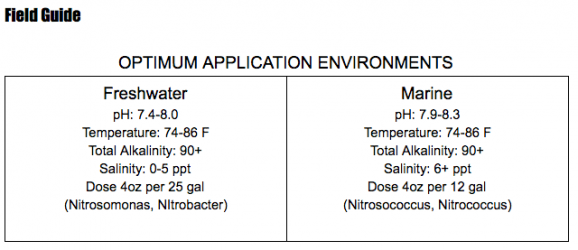"Media exchange from another system" was included in the 'long cycle'.
I'd say that the variable NOT being discussed in this type of cycling method is that the amount of media brought over, the amount of bioload in the donor tank and the amount of bioload in the new tank are huge in determining how quickly it will cycle.
They said this:
"Media exchange just does not compare to adding a bottle of ATM's Colony, and really its not even close."
And I agree. Media Exchange is WAY better.
Then he claims:
"This is why the Instant Cycle from ATM takes DAYS, while the Long cycle can take 4-6 weeks." This is extremely MISLEADING. Having not dealt with any of the actual variables in media exchange as a cycle booster, they have NOT established why it would take 4-6 weeks. And honestly, a seeded cycle with a media exchange will NEVER take 4-6 weeks, because it introduces a significant amount of bacteria, already inside its appropriate biofilm, ready to process ammonia and ready to reproduce more bacteria with very little effort.
In my own experience, I've gotten 'days' from media exchanges (including when I was upgrading to a tank that was TWICE the volume of the donor tank) and in a few cases even got a truly 'instant' cycle (when cloning a filter for a much smaller tank for a much smaller bioload).
The biggest difference with media exchange versus bottled bacteria, there's NO QUESTION about the viability of the bacteria being added. The bottled products can be expired, can be exposed to extreme temperatures and you could be adding dead bacteria. The media exchange where you know what has happened to the media from the time it was pulled out of the tank to the time it was added to the new tank is a known variable. You know exactly what happened to it and how long its been separated from the tank. In my opinion, media exchange is THE SINGLE MOST EFFECTIVE METHOD. You KNOW you are adding viable bacteria. The only question is how much you are adding. And even if you are adding just a little... you are adding it in the right ratio and the entire cycle goes very smoothly.
I also take issue with the notion that 'DAYS' refers to an "INSTANT" cycle. INSTANT means just that. If the comparison is "LONG" for 4-6 weeks, then the thing that takes "DAYS" is by no means 'instant', but merely 'SHORT'. But, "SHORT" doesn't sell nearly as well as 'INSTANT'. People want things INSTANTLY, not just fast these days.
"Would you really want to wait 4-6 weeks to find out if your aquarium can support nitrifiers let alone fish? Days is much better." Honestly, just a bait and switch tactic. It wouldn't take 4-6 weeks to find out if nitrifiers are showing up in the tank.

Very disappointing 'advertising'. And the grocery store analogy... just terrible.
Next... the 'optimum conditions' for the nitrifiers is accurate, except that many of the fish kept in the hobby do NOT like those conditions. So, they need to be clear that the conditions they are suggesting are specific for the bacteria, NOT THE FISH!
The MYTHS section:
"Nitrobacters won't work in aquariums."
The 'nitrobacter' bacteria they are adding might be why it takes as long as 'weeks'. This isn't the right bacteria, as Byron pointed out, compared to what the research says should be in the tank. It might deal with nitrite a little, but it won't be the long term solution.
Nitrobacters DO nitrify, but as he pointed out they are used largely in waste treatment plants. Why? because they THRIVE in high concentrations, but not in low concentrations. They 'work', but they aren't nearly as efficient. Nitrospira, on the other hand, are great in very low concentrations... along the lines of 0.14 ppm, whereas the nitrobacters work best at concentrations about 100x higher than that! Nitrospira die at those high levels and while nitrobacters may not die at those lower levels, they don't compete as well as the nitrospira under those parameters. (He acknowledges the importance of water parameters, but ignored all the ramifications of it.)
 /acrylictankmanufacturing.com/products/water-treatment/biologicals/colony-nitrifying-bacteria/
/acrylictankmanufacturing.com/products/water-treatment/biologicals/colony-nitrifying-bacteria/  /acrylictankmanufacturing.com/products/water-treatment/biologicals/colony-nitrifying-bacteria/
/acrylictankmanufacturing.com/products/water-treatment/biologicals/colony-nitrifying-bacteria/ 


 Very disappointing 'advertising'. And the grocery store analogy... just terrible.
Very disappointing 'advertising'. And the grocery store analogy... just terrible.